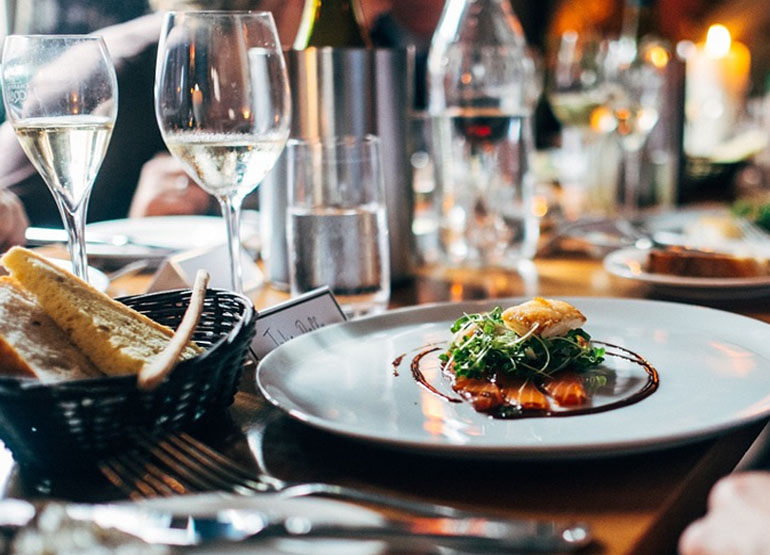Health Pages
Diet and Eating Out
Diet and Eating Out
Unrestrained eating out is the perfect recipe for obesity and disease down the road. Even if you carefully follow your eating plan recommendations at home, it is often more difficult to follow them when dining out. So what's the answer? Refuse to eat out? On the contrary, you can eat out successfully and enjoy your experience by learning how to eat out. Also, make sure you know before you go. It's easy, because most restaurants these days have menu posted online and you can check their offers. And remember to be aware of serving sizes. It's not only what you eat or drink that adds calories but also how much.
Your body is equipped to know when you have had enough food. Feeling full is a result of your brain reacting to chemicals released when you put drink or food in your stomach. Keep in mind that your brain takes around 20 minutes to register these chemicals. So don't keep nibbling until your plate is empty, try to react to first signal that you are full, no matter how big the serving size.
Here are some easy to follow tips that will help you eat smart while dining out and also help you stick to your eating plan:
1. Choose restaurants that serve such healthful entrees as baked or broiled chicken or fish, grilled chicken, grilled vegetables and broth-based soups.
2. Don't be afraid to make special requests. Be POLITE but ASSERTIVE when ordering meals. If asked, many restaurants will prepare foods as you request - broiled instead of fried, for example.
3. Stay away from appetizer trays before the actual meal begins, they can pile up fat and calories that you don't need.
4. Avoid foods that have been deep-fried in fat.
5. Have sauces and salad dressing served on the side. This will let you limit the size of portions. Also pick calorie-friendly dressings (vinaigrettes, low-fat and low-cal dressings, even a generous squeeze of fresh lemon).
6. Oriental restaurants can be good choices. Order dishes that feature small portions of chicken, fish, or lean meat, stir fried with vegetables in small amounts of oil.
7. Italian restaurants can also be wise choices. Pasta with tomato sauce is a filling low-fat meal. Avoid high fat cheeses, sausages, and fatty cuts of meat.
8. At delicatessens, choose a sliced turkey or lean roast beef sandwich rather than high fat sandwich meats and cheeses. Choose lettuce or sliced tomatoes, instead of fries or chips.
9. Even at fast-food restaurants, you can find relatively low-fat choices. Unfortunately their fish and chicken are usually deep-fried in saturated fat. Try a small broiled hamburger, grilled chicken, a roast beef sandwich or salad.
10. Eat a low-fat snack before going to a party or a buffet where there will be a lot of high fat food. Also, drink a full glass of water 10 minutes before meal; your brain will realize you are full within 10 minutes (instead of the usual 20 minutes). This will curb your appetite and help prevent overeating.
11. Drink water, or mineral water, instead of sodas, premixed alcoholic beverages, sugary coffee drinks, hot chocolate. iced tea, and juices.
12. When dining with friends, it may be difficult to refuse high-fat foods. Eat small amounts of these foods and concentrate on the low-fat foods offered. With good friends, discuss your diet in advance. Don't be surprised if your hosts are also concerned about cholesterol.
13. Avoid potato salads, macaroni salads, coleslaw and even tuna and chicken salads, which usually are heavy in mayonnaise, sugar and calories.
14. Wave off the dessert cart and satisfy your sweet tooth with fresh fruit. If you truly want that delicious cake, go ahead and have it, but limit yourself to a taste. Take three bites and then set it aside for a few minutes. You're less likely to come back to it. If you can't exercise control, have your server remove the temptation.
15. When traveling by plane, request a low-fat, low-cholesterol meal when you order your ticket. Many airlines will honor your request.
ABOUT THE AUTHOR
© Maya Gavric, entrepreneur, consultant, freelance writer, web developer, artist, former realtor, and marketing coach has been working, researching and reporting on the Internet for years. Her numerous articles and books offer valuable insight and tips on wide variety of topics. In recent times she has paid particular attention to knowledge management on the Internet, health topics and environmental problems, exploring how our attention to hot issues might best transform current situation into better practice. For more health tips and info visit: Romwell Health Pages
Learn more:



